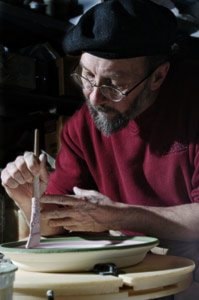Local artist Patrick Royle’s pottery career got off to a rocky start.
In junior high school he was forbidden to use the potter’s wheel because his art teacher did not think he was talented enough.
It wasn’t until 1976, when he took a pottery course in Victoria BC, that his talent was discovered.
While the rest of the beginner students were struggling with little cups and bowls, Royle was on the wheel, making teapots and spinning clay like a pro.
Now, his Fireweed Pottery series has been recognized as one of Canada’s premier ceramics production lines at the Gardiner Museum in Toronto. There, a place setting of his will be on display February 15 to April 22.
Royle’s Raven Pottery studio is one of only 40 Canadian studios to be included in this national exhibition throughout the last century.
“I think they looked across the country at who worked in production pottery, not just doing one-off art pieces,” said Royle from his Marsh Lake studio.
“Production pottery provides them with a mix of art, design and industry that I think they were looking for.”
Following the national exposure, Royle says that he hopes his pots double in price.
He is also looking forward to meeting with other top potters from around Canada to exchange ideas and thoughts about production pottery.
The fireweed, Yukon’s territorial flower, is represented on every item in this collection, which has more than 100 pieces.
Its bright, pink blossoms and wispy green stems cover the majority of the inside of a dinner plate or bowl against a background of white glaze. Rings of green and pink grace the edges of the pieces.
Royle chose the fireweed flower as the focus of his most popular line of pottery because the brush strokes needed to replicate the flower are similar to the Asian influenced painting he’d been practising before the birth of his fireweed line in 1985.
“By 1985 I knew that I was never going to be Japanese and bamboo was never going to grow in the Yukon,” he said.
Royle became a full-time potter because he couldn’t manage to get to his day job on time.
He was working at the Yukon Gallery in Whitehorse and because he was spending all night at the potter’s wheel he was habitually late for work in the morning.
“It soon became evident that I would be better off making pots full-time,” said Royle.
“(My bosses) pretty much decided that for me.”
His decision to become a production potter, mass-producing a line that has been sold to collectors all over the world, was encouraged by his desire to make a living out of making pots.
“One-off things are always in your head but they don’t always earn a living,” said Royle.
“They cause excitement and trouble and make statements instead.”
Royle now has seven lines of pottery in addition to his Fireweed line and is often commissioned to provide gift baskets of his pottery and other Yukon paraphernalia for corporate conferences.
But Royle is not all business when it comes to his craft.
One of his hobbies is making glazes, which he describes as less of a scientific process than alchemy.
“In the world past, it’s a world of alchemy,” he said.
“There’s a certain amount of serendipity to it when you add, say, three per cent of this and one per cent of this to get the right colour and consistency of glaze.”
Royle also enjoys the fact that, as a studio potter, he can be involved in every step of the process from the birth of an idea to the production of the line.
“You’re everything — you’re the designer, you’re the artist, you’re the alchemist, the producer,” he said.
For somebody who never thought he would end up a production potter, Royle now gets frustrated when he can’t finish a piece fast enough.
His studio is filled with shelves holding uniform plates, bowls and cups, all waiting to be painted, fired and shipped.
The potter is currently looking for ways to streamline production.
Before he heads to Toronto for the Gardiner Museum exhibit opening, he will attend a workshop in Vancouver. There, he will learn techniques to improve his production methods and reproduce his own designs more quickly.
At some point, he wouldn’t mind having a couple of studio assistants to speed things up.
Although he is working to increase his output, he doesn’t intend to compromise his artistry.
“That’s what makes it quite unique, it’s all hand done,” said Royle.
Of course, it depends if he’s had a good night’s sleep and his hands aren’t shaky, he joked.
“Sometimes I shouldn’t even be at the wheel,” he said.
A potter has a varied life.
“It’s not just one thing,” said Royle, who teaches the craft at Yukon Arts Underground.
“It’s the combination of art, science, life and philosophy.”
And, during the Canada Winter Games, he’ll host fellow artists from the Northwest Territories and Nunavut.
Despite his ties to the extended artists’ community, making pots is solitary work.
Every day, he sits at his wheel creating and painting with only a radio for company.
“Everyday I’m involved in the operation of Raven Pottery in one way or another,” he said.
“Most visual and literary artists do work in solitary, that’s what separates us from the performing arts — it’s what we have in common.
“You can dream up a lot of things while sitting behind the wheel of a tractor.”
